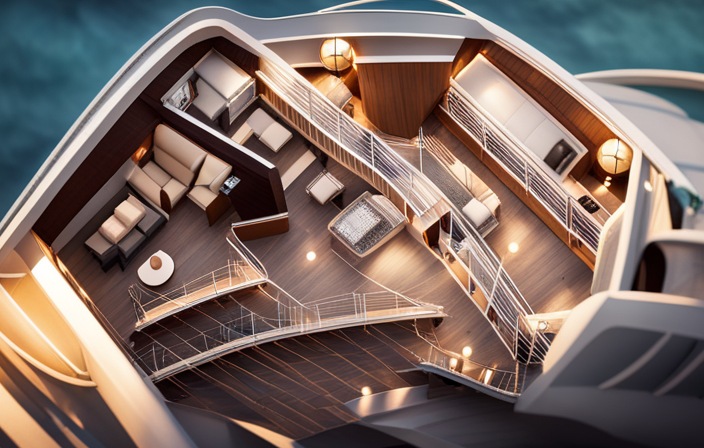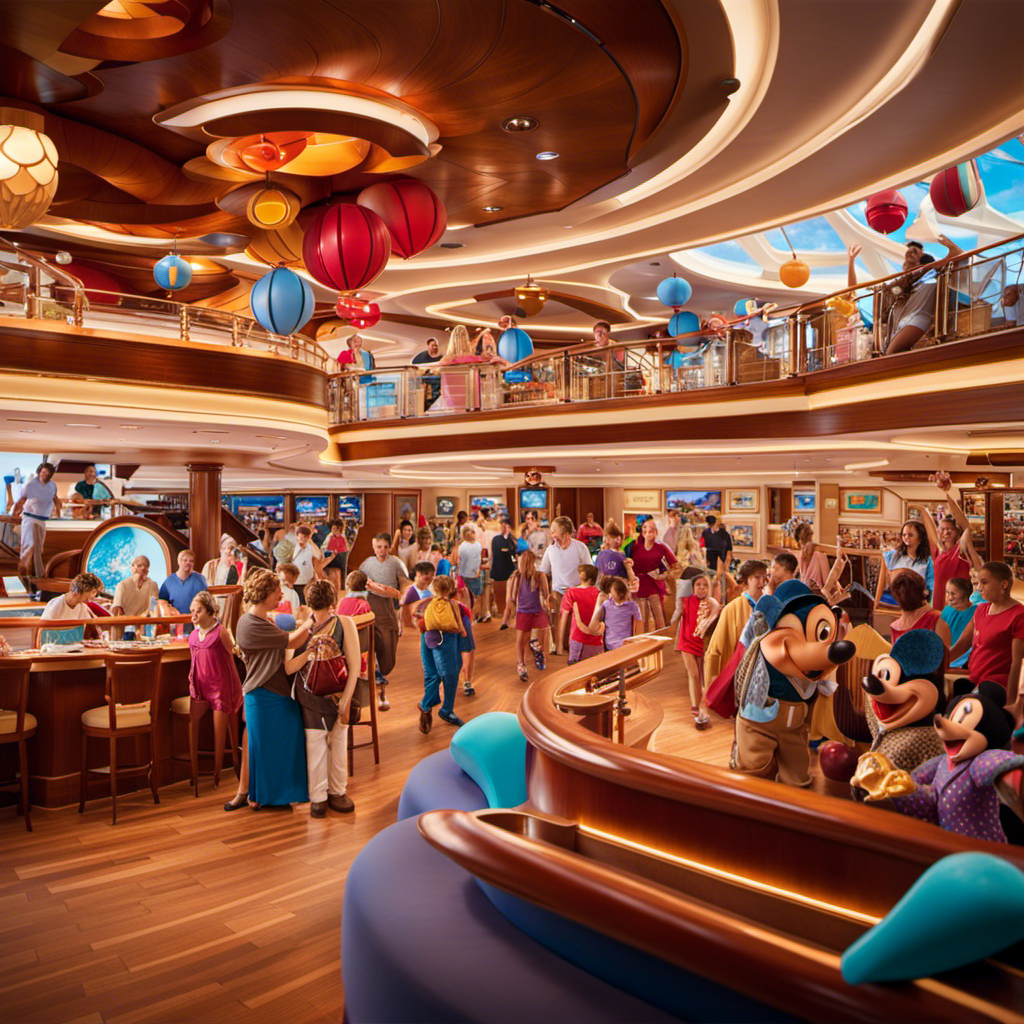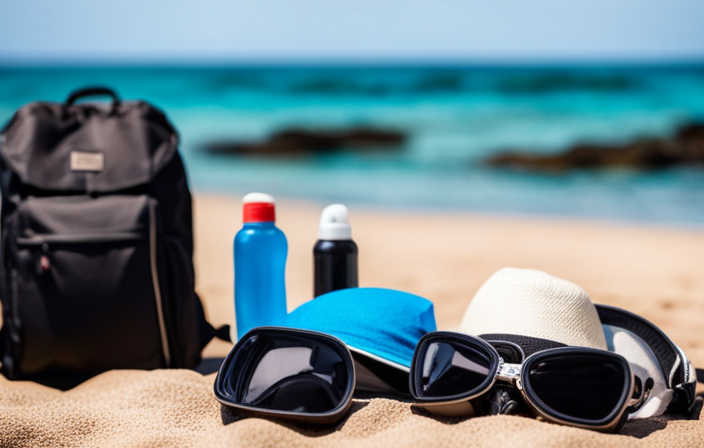As soon as I step onto a cruise ship, its decks’ grandeur and vastness immediately capture my attention. The massive edifice stands before me, its sleek exterior glistening in the sunlight.
But as I begin to explore, I can’t help but wonder, how are these decks numbered? How do I navigate my way to the amenities and facilities? And most importantly, how do I find my cabin amidst the labyrinth of corridors? These questions are not uncommon, as cruise ship deck numbering can be a bit perplexing.
However, fear not, for I am here to guide you through the intricacies of this system. In this article, we will delve into the basics of cruise ship deck numbering, understand the logic behind it, and learn some fascinating facts along the way.
So, grab your boarding pass and let’s embark on this journey together.
Key Takeaways
- Cruise ship decks are numbered from bottom to top, with lower deck numbers for public areas and higher deck numbers for passenger cabins.
- Some ships may have exceptions or variations in their numbering system, so it’s important to familiarize yourself with the specific system used by the ship you are on.
- Deck numbering typically starts at the lowest deck, which is Deck 1 or the Lower Deck, but this may vary between cruise lines. Large cruise ships can have up to 16 or more decks.
- While the numbering system is generally sequential, there may be separate numbering for crew or public decks, and some areas may have special names instead of numbers, adding to the sense of adventure on a cruise.
The Basics of Cruise Ship Deck Numbering
So, you’re probably wondering how cruise ship decks are numbered, huh? Well, let me break it down for you.
Understanding deck layouts and the importance of deck numbering is crucial for any cruise ship enthusiast or traveler. Cruise ships are massive floating cities, and their decks are like the different floors of a building.
Each deck is assigned a number, starting from the bottom and moving upwards. The numbering system typically follows a logical pattern, with lower deck numbers assigned to public areas like restaurants and entertainment venues, while higher deck numbers are reserved for passenger cabins. This helps passengers easily locate their desired destinations on the ship.
Now, let’s delve into understanding the numbering system and how it aids in navigating these floating marvels.
Understanding the Numbering System
When it comes to understanding the numbering system of cruise ship decks, there are a few key points to consider.
First, it’s important to know how the numbering starts. Typically, the numbering begins at the lowest deck, which is often called Deck 1 or the Lower Deck. From there, the numbering progresses upwards, with each subsequent deck being assigned a higher number.
Additionally, it’s worth noting that there are exceptions and variations to the standard numbering system. For example, some cruise ships may have a deck labeled as ‘Deck 0’ or ‘Deck A,’ which is typically located below the Lower Deck. This can be a bit confusing for first-time cruisers, but it’s important to familiarize yourself with the ship’s specific numbering system to avoid any confusion or getting lost on board.
Overall, understanding how the numbering starts, how it progresses, and any exceptions or variations is crucial for navigating a cruise ship with ease.
How the Numbering Starts
The numbering of cruise ship decks typically begins with the lowest deck, which is often referred to as Deck 1 or the Lower Deck. This is the starting point of the numbering system used on cruise ships.
It is important to note that the numbering may vary slightly between different cruise lines and ships, but the general principle remains the same. As you move up the ship, the deck numbers increase accordingly.
Interestingly, some large cruise ships can have up to 16 or more decks in total. Each deck serves a specific purpose and is designated with a number to ensure ease of navigation for both passengers and crew.
As we delve deeper into the topic, we will explore how the numbering progresses and what factors may influence it.
How the Numbering Progresses
As you journey higher on the vessel, the deck numbers continue to rise accordingly, ensuring smooth navigation for all on board. The progression of deck numbering on a cruise ship is typically straightforward and logical. Most ships follow a sequential numbering system, starting from the lowest deck and progressing upwards. However, there can be variations depending on the ship’s design and purpose. For example, some ships may have a separate numbering system for crew decks or public decks. Additionally, certain areas of the ship, such as the promenade deck or sun deck, may be given special names instead of numbers. These variations add uniqueness to each ship’s layout and enhance the overall experience for passengers. Moving forward, let’s explore the exceptions and variations in cruise ship deck numbering.
Exceptions and Variations
To add a touch of uniqueness and enhance the overall experience, certain areas of the ship, like the promenade deck or sun deck, may have special names instead of numbers. These exceptions and variations serve to create a more memorable and enjoyable cruise for passengers.
For instance, instead of being labeled with numbers, the promenade deck might be named after a famous city or landmark, like the ‘New York Promenade’ or the ‘Eiffel Tower Deck.’ Similarly, the sun deck might be called the ‘Paradise Terrace’ or the ‘Serenity Lounge.’ These special names not only make it easier for passengers to remember and locate these areas, but they also add a sense of excitement and adventure to the cruising experience.
Speaking of locating amenities and facilities, let’s explore how passengers can easily find everything they need on board.
Locating Amenities and Facilities
Navigate the cruise ship decks with ease by utilizing the clear signage and deck plans to easily locate amenities and facilities.
When it comes to finding a place to eat, the restaurants on board are usually located on specific decks. These decks are often clearly marked and can be easily identified on the deck plans. From casual dining to fine dining options, the variety of restaurants ensures that there is something for everyone’s taste.
Finding entertainment is a breeze as well. The theaters, lounges, and clubs are typically located on specific decks, making it easy to find the perfect spot for a night of fun and entertainment.
After exploring all the amenities and facilities, it’s time to navigate to your cabin without missing a beat.
Navigating to Your Cabin
Don’t worry about getting lost, finding your cabin is a breeze with the helpful signage and floor plans. Once you step onto the cruise ship, you’ll be given a map that outlines the deck layout, making it easy to navigate. If you’re traveling with cabin mates, the map will indicate where their cabins are located, ensuring you can find each other easily. Additionally, the signage throughout the ship will guide you to the different public spaces and amenities available, such as restaurants, pools, and entertainment areas. These signs are strategically placed and easy to follow, so you won’t have any trouble locating your desired destination. Now that you know how to find your cabin and navigate the ship, let’s dive into some fun facts about cruise ship deck numbering.
Fun Facts About Cruise Ship Deck Numbering
As someone who has spent a significant amount of time on cruise ships, I find the topic of how cruise ship decks are numbered quite fascinating. But before we dive into tips for navigating the ship, let me share some fun facts about cruise ship deck numbering.
Did you know that the numbering system used for cruise ship decks has historical origins? In the early days of ocean liners, decks were simply named after prominent features or areas of the ship. However, as ships grew larger and more complex, a standardized numbering system was introduced.
The main deck became the lowest deck, numbered one, and subsequent decks were numbered consecutively upwards. Some ships even have decks with letters instead of numbers, adding a unique twist to the numbering system.
Now that you know this interesting bit of trivia, let’s move on to some helpful tips for navigating the ship.
Tips for Navigating the Ship
When it comes to navigating a cruise ship, there are a few key tips that I always keep in mind.
-
First and foremost, paying attention to signs and markers is crucial in order to find your way around.
-
Additionally, using technology and digital maps can be extremely helpful in navigating the ship, especially if you’re not familiar with its layout.
-
And finally, don’t hesitate to ask for assistance if needed. The staff on board is always ready and willing to help guide you in the right direction.
Paying Attention to Signs and Markers
Keep an eye out for signs and markers while onboard a cruise ship to ensure you don’t miss any important information about deck numbering. Paying attention to these signage is crucial for following directions and navigating the ship smoothly. Here are three reasons why signs and markers are important:
-
Easy Navigation: Signs and markers help you identify the different areas of the ship, such as restaurants, bars, and entertainment venues. They guide you towards your desired destination, saving you time and minimizing confusion.
-
Safety Measures: Signage also plays a vital role in ensuring your safety onboard. They indicate emergency exits, muster stations, and life-saving equipment locations. By following these markers, you can quickly find your way in case of an emergency.
-
Information Hub: Signs provide valuable information about the ship’s amenities, schedules, and activities. They keep you updated on what’s happening around the ship, making it easier to plan your day and make the most of your cruise experience.
By paying attention to signs and markers, you’ll have a smooth sailing experience. Next, we’ll explore how using technology and digital maps can further enhance your navigation onboard.
Using Technology and Digital Maps
To enhance your navigation onboard, you can utilize technology and digital maps available on your smartphone or tablet.
Imagine using a navigation app that shows you a detailed map of the ship, highlights key areas, and provides real-time updates on activities and events happening around you.
These digital navigation tools have become increasingly popular on cruise ships, allowing passengers to easily find their way around the ship and discover all the amenities and attractions it has to offer.
Interactive ship maps provide a user-friendly interface, allowing you to zoom in and out, search for specific locations, and even get directions to your desired destination.
With just a few taps on your screen, you can quickly navigate through multiple decks and efficiently plan your day.
If you require assistance, don’t hesitate to ask the friendly staff or crew members who are always available to help you.
Asking for Assistance if Needed
If you find yourself in need of help, the friendly staff and crew members are always available to assist you. They are trained to provide excellent customer service and are knowledgeable about the ship’s layout and amenities.
If you have trouble finding a specific location on the ship, don’t hesitate to ask for assistance. The staff can help you navigate the decks and guide you to your destination. They can also provide information about the various amenities available on the ship, such as restaurants, lounges, and entertainment venues.
Additionally, they can assist with any accessibility considerations you may have, ensuring that your experience on the cruise ship is comfortable and enjoyable. With their help, you can easily make your way around the ship and take advantage of all the amenities it has to offer.
Now, let’s discuss some accessibility considerations to keep in mind when onboard.
Accessibility Considerations
When considering accessibility on cruise ships, it’s crucial to understand the numbering system for the decks. Cruise ships typically use a numbering system that starts from the bottom and goes up, with lower decks having lower numbers and higher decks having higher numbers. This system simplifies navigation for passengers, allowing them to easily locate different areas of the ship. In terms of accessible design, cruise ships prioritize incorporating inclusive features to ensure that passengers with disabilities can move around comfortably. These features include wheelchair-accessible cabins, ramps, wider doorways, and elevators that reach all decks. They are crucial in providing a seamless experience for passengers with mobility challenges.
Now, let’s transition to the next section, which focuses on safety and emergency preparedness.
Safety and Emergency Preparedness
When it comes to safety and emergency preparedness on a cruise ship, there are several key points to consider.
First and foremost, it is crucial to know the location of emergency exits and assembly stations, as this information can be vital in the event of an emergency.
Additionally, familiarizing yourself with safety procedures, such as the proper use of life jackets and emergency equipment, is essential to ensure your own safety and the safety of others.
Lastly, understanding the ship’s evacuation plans will help you to navigate the ship and evacuate efficiently in the case of an emergency.
Knowing Emergency Exits and Assembly Stations
Knowing the emergency exits and assembly stations is crucial for passengers on a cruise ship to ensure their safety in the event of an emergency. To make your cruise experience more enjoyable and stress-free, here are three important things to remember:
-
Familiarize yourself with the location of emergency exits on the ship. Take note of the nearest exits to your cabin, dining areas, and recreational spaces. This knowledge will help you quickly evacuate to safety if necessary.
-
Know the designated assembly stations. These are specific areas where passengers gather during an emergency. Familiarize yourself with the assembly station closest to your cabin, as well as alternative stations in case your primary one is inaccessible.
-
Pay attention to the safety briefings provided at the beginning of your cruise. These briefings will give you important information on emergency procedures, including how to use life jackets and what to do in the event of an evacuation.
By understanding emergency exits and assembly stations, you can be better prepared for any unexpected situation on a cruise ship.
Now, let’s move on to familiarizing ourselves with safety procedures.
Familiarizing Yourself with Safety Procedures
To ensure a smooth and secure voyage, it’s essential to acquaint yourself with the safety procedures in place onboard. Safety drills are regularly conducted on cruise ships to ensure that passengers are familiar with emergency protocols. These drills are crucial because in the event of an emergency, knowing what to do can save lives.
Pay attention during the safety briefing at the beginning of your cruise, as it will provide important information about evacuation procedures and the location of life jackets and emergency exits. Familiarizing yourself with these procedures will enable you to respond quickly and effectively in case of an emergency.
Understanding the importance of familiarization, I now move on to discussing the next section about understanding evacuation plans.
Understanding Evacuation Plans
Understanding evacuation plans is essential for ensuring the safety of all passengers on board. In the event of an emergency, knowing the proper evacuation procedures and following the established emergency protocols can make a significant difference in the outcome.
Here are four crucial elements of cruise ship evacuation plans:
-
Lifeboat Stations: Each passenger is assigned to a specific lifeboat station, which they must locate and proceed to in an organized manner.
-
Life Jackets: Passengers must familiarize themselves with the location of life jackets and how to properly wear them.
-
Emergency Drills: Regular emergency drills are conducted to ensure that passengers are familiar with the evacuation process.
-
Crew Assistance: Trained crew members are stationed throughout the ship to provide guidance and assistance during evacuations.
Understanding these aspects of evacuation plans is vital for passenger safety. It is important to be knowledgeable and prepared in order to react quickly and efficiently during an emergency.
Moving on to common mistakes and misconceptions, it is crucial to address some key points to avoid any misunderstandings.
Common Mistakes and Misconceptions
Contrary to popular belief, cruise ship decks are not always numbered sequentially. For instance, the Titanic had eight decks, but the numbering skipped the unlucky number 13, so there were actually only seven numbered decks on the ship.
This is just one example of a common misconception when it comes to cruise ship deck numbering.
Another common error is assuming that the deck numbers correspond to the number of floors in the ship. In reality, deck numbers are assigned based on their position relative to the waterline. The lower decks are typically numbered with single digits, while the upper decks have higher numbers.
Understanding these common mistakes and misconceptions can help passengers navigate the ship more easily and avoid confusion.
Moving on to the summary and final thoughts, it’s important to be aware of these nuances in cruise ship deck numbering to have a smooth and enjoyable experience on board.
Summary and Final Thoughts
To summarize, the common mistakes and misconceptions about how cruise ship decks are numbered are easily cleared up with a little bit of knowledge.
It is important to understand that cruise ships typically label their decks with numbers, starting from the lowest deck and moving upwards. However, some ships may also use letter designations for certain decks.
Additionally, it is crucial to realize that the deck numbering system may vary slightly between different cruise lines. It is recommended to familiarize yourself with the specific numbering system of the cruise ship you are planning to sail on to avoid any confusion.
In conclusion, understanding how cruise ship decks are numbered is a simple matter of research and paying attention to the details provided by the cruise line.
Frequently Asked Questions
What are some common mistakes people make when trying to navigate cruise ship decks?
Some common mistakes people make when trying to navigate cruise ship decks include not consulting the ship’s deck plan, not paying attention to signage, and relying solely on memory. Efficient navigation is key.
Are there any accessibility considerations to keep in mind when navigating cruise ship decks?
When navigating cruise ship decks, it’s important to consider accessibility challenges. To navigate with ease, use elevators instead of stairs, familiarize yourself with deck layouts, and ask for assistance if needed.
What are some safety and emergency preparedness measures that are important to know on a cruise ship?
In case of emergencies onboard a cruise ship, it is crucial to participate in emergency drills and familiarize yourself with safety equipment. As an experienced cruiser, I emphasize the importance of being prepared for any unforeseen situation.
Can you provide some fun facts about cruise ship deck numbering?
Interesting origins and unique numbering systems exist for cruise ship decks. For example, some ships use numbers while others use names. Understanding these variations adds to the fun of exploring different decks on a cruise ship.
Do you have any additional tips for navigating the ship efficiently?
Efficient navigation on a cruise ship can save valuable time. To maximize efficiency, familiarize yourself with the ship’s layout, utilize helpful signage, and plan your activities in advance. These strategies will ensure a smooth and enjoyable experience onboard.
Does knowing how much a cruise ship waiter makes affect the organization of the ship’s decks?
Understanding cruise ship waiter salary information can indeed impact the organization of the ship’s decks. This knowledge can help leaders allocate resources more effectively, ensuring that waitstaff are compensated fairly and that service levels remain high. It can also influence staffing decisions and morale among the crew.
Conclusion
In conclusion, navigating cruise ship decks may seem daunting, but with a little understanding of the numbering system and attention to detail, it can be a breeze.
By familiarizing yourself with the amenities and facilities, locating your cabin becomes a seamless process.
Remembering some fun facts about deck numbering adds a touch of sophistication to your cruise experience.
Additionally, being aware of accessibility considerations and safety protocols ensures a smooth and enjoyable journey.
So, set sail with confidence and embrace the adventure that awaits you on the high seas.
Meet Asra, a talented and adventurous writer who infuses her passion for exploration into every word she writes. Asra’s love for storytelling and her insatiable curiosity about the world make her an invaluable asset to the Voyager Info team.
From a young age, Asra was drawn to the power of words and their ability to transport readers to far-off lands and magical realms. Her fascination with travel and cultures from around the globe fueled her desire to become a travel writer, and she set out on a journey to turn her dreams into reality.











